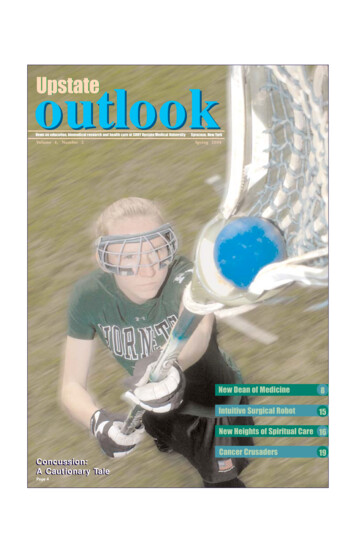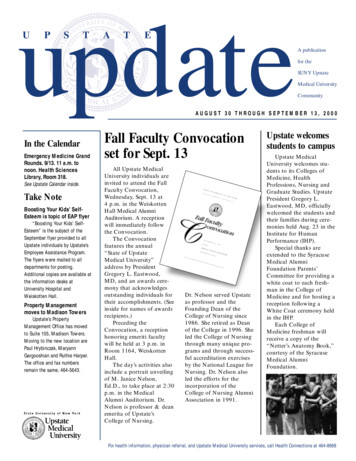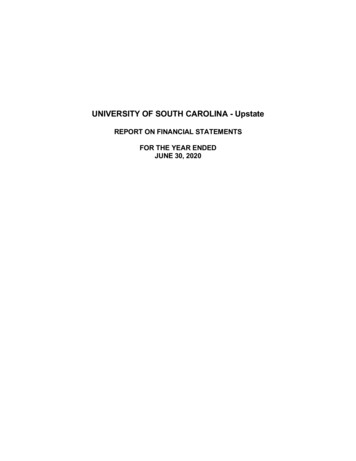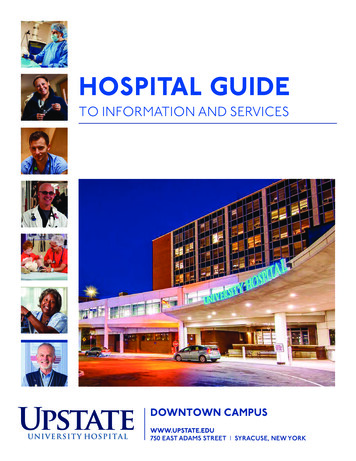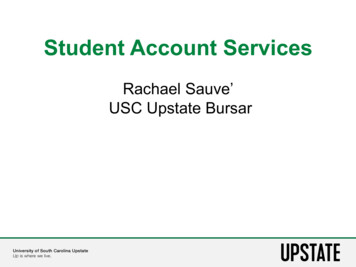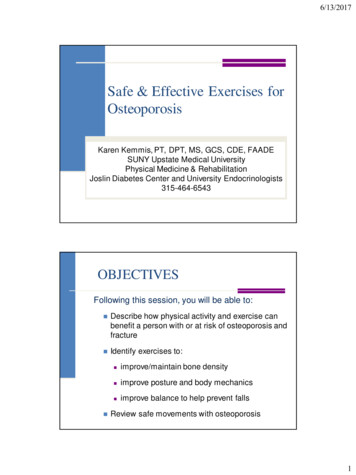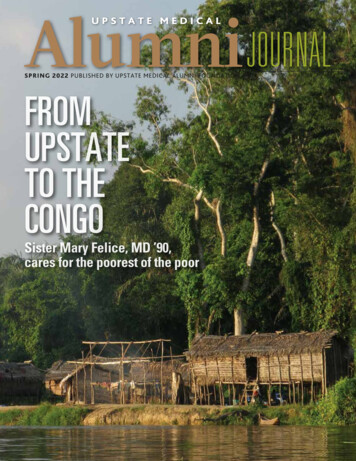
Transcription
Alumni JOURNALUPSTATE MEDICALSPRING 2022 PUBLISHED BY UPSTATE MEDICAL ALUMNI FOUNDATIONFROMUPSTATETO THECONGOSister Mary Felice, MD ’90,cares for the poorest of the poor
M ED I C A L A L U M NIB O A R D O F D I R EC T O R S57Larry S. Charlamb, MD ’88PresidentBarbara A. Morisseau, MD ’98Vice PresidentThomas A. Bersani, MD ’82TreasurerDanielle A. Katz, MD ’97SecretaryRichard M. Cantor, MD ’76Peter J. Christiano, MD ’85Barbara Jones Connor,MD ’82Dennis D. Daly, MD ’83Mantosh Dewan, MDRobert A. Dracker, MD ’82Mark S. Erlebacher, MD ’79Brian J. Gaffney, MD ’72Douglas W. Halliday, MD ’79Ruth H. Hart, MD ’80Robert H. Hill, III, MD ’06Bruce M. Leslie, MD ’78Barbara Clayton Lutz, MD ’92Kirsten P. Magowan, MD ’87Mark S. Persky, MD ’72Amy L. Reynders, MD ’01Charles J. Ryan III, MD ’82K. Bruce Simmons, MD ’79George L. Stanley, Jr., MD ’94Ralph L. Stevens, MD ’81James A. Terzian, MD ’75EMERITUSFrederick R. Davey, MD ’64Richard W. DoustKaren K. Heitzman, MD ’83Patricia J. Numann, MD ’65Michael H. Ratner, MD ’68Gregory A. Threatte, MD ’73Jack Yoffa, MD ’69EX-OFFICIOLawrence Chin, MDChristopher Morley, PhD,MA, CASPaul NorcrossJulie White, PhDHONORARYSadri GarakaniSTUDENTREPRESENTATIVESHaley Burdge ’22Tyler Fuller ’22BinghamtonBarnes Werner ’23Casey Manzanero ’23BinghamtonGavrielle Rood ’24Nathan Ihemeremadu ’25AlumniJOURNALUPSTATE MEDICAL13Features7College of Medicine Receives Naming GiftA 25-million gift from Alan Norton, MD ’66, and his wife Marlene, is poisedto transform teaching at the College of Medicine.13 Doing Much With LittleSister Mary Felice, MD ’90, cares for the poor at a remote hospital in the Congo.Departments1182031COURTYARDSTUDENT ROUNDSCLASS NOTESIN MEMORIAM23SPRING 2022 ISSUEPublished three times in2022 in spring, autumn, andwinter. Copyright 2022by Upstate Medical AlumniFoundation. Opinionsexpressed are those ofthe individual authors andsubjects and do not necessarily reflect the views ofthe Alumni Foundation orUpstate Medical University.Published by the UpstateMedical Alumni Foundationof Upstate Medical University, Setnor AcademicBuilding #1510, 750 E.Adams St., Syracuse,New York 13210-9976Issue Number: 85Submissions and addresscorrections should be sentto Paul Norcross, SUNYUpstate Medical University,Setnor Academic Building#1510, 750 E. Adams St.,Syracuse, New York13210-9976Phone: 315/464-4361Fax: 315/464-4360Email:norcrosp@upstate.eduPaul NorcrossExecutive EditorRenée Gearhart LevyManaging EditorSarah BurnsEllen EdgertonLori MurphyChere RavenContributing EditorsKiefer CreativeDesign and ProductionWilliam MuellerDebbie RexineRich WhelskyPhotographersMichael H. Ratner, MD ’68,ChairThomas Bersani, MD ’82Fred Davey, MD ’64Ruth Hart, MD ’80James Terzian, MD ’75Editorial BoardJUST A CLICK AWAYVisit the Medical Alumniweb page at medalumni.upstate.edu for specialevent information, pastAlumni Journals, givingopportunities, and more.Follow us on Facebook atwww.facebook.com/UpstateMedicalAlumniON THE COVER: Homes on the river inremote Lukolela, Demo cratic Republic of Congo,where Sister Mary Felice,MD ’90, serves as medicaldirector of St. Vincent theServant General ReferenceHospital.CORRECTION:In the Winter 2021 issue,a reference to LeslieKohman, MD, failed to listher as HS ’85.
C O U R T YA R DUpstate Medical University Seeks Approvalto Acquire Crouse HealthI N A P R I L , S U N Y U P S T A T E Medical University announced its intention to acquire Crouse Health,a plan to bring the two healthcare systemstogether to enhance care delivery to CentralNew Yorkers.The proposed combination includes allof Crouse Hospitals’ inpatient and outpatientservices, which will be renamed Upstate CrouseHospital. Crouse Medical Practice will remainintact and will be branded as Upstate CrouseMedical Practice.The combined entity will have more than13,000 employees, 1,200 licensed inpatienthospital beds and offer more than 70 specialties.Upstate said the deal is not expected to result inany job cuts and employees at both hospitals willcontinue to be represented by the same unions.Crouse, which has 3,200 employees, hasbeen operating in Syracuse for 135 years. It deliversmore than 3,800 babies annually, more than anyother hospital in the region. It cares for high-riskobstetric patients referred by smaller hospitalsthroughout the region. It also operates a neonatalintensive care unit.Upstate Medical University is the region’slargest employer with nearly 11,000 employees.Its hospital system is known for specializedservices such as burn and trauma care, cancercare, stroke care, and pediatric services providedthrough the Golisano Children’s Hospital.Upstate is part of the State University of NewYork. It has 1,600 students studying medicine,nursing and other health professions. Upstatealso conducts more than 40 million in fundedresearch annually.As neighbors on the University Hill, Upstateand Crouse have long discussed ways to moreclosely align to improve care for the communityand region. During the pandemic, Upstate andCrouse worked collaboratively to meet the challenges created by COVID-19.“There has been a natural progression in ourrelationship over the years. Between the twoorganizations, there are many clinical services thatcomplement each other. Formalizing the relationship with Crouse—and making it a key componentof our University Hospital system—would allowthese services to flourish,” says Robert Corona,DO, CEO of Upstate University Hospital.“Discussions between Crouse and Upstate havealways revolved around creating the best environment possible for patients, medical professionalsCrouse Hospital and Upstate Medical University are longtime neighbors on University Hill.and dedicated staff,” adds Patrick A. Mannion,Crouse Health board chair. “The Board determinedthat integration with a local partner was the bestoption for Crouse, and given our history, Upstatewas the preferred choice, one that the communitywill embrace.”Mantosh Dewan, MD, president of Upstate,believes the combined expertise will benefitpatient care while preserving jobs and theeconomic health of the region. “Building uponour combined strengths will be a significant stepin shaping the future growth of the region’s onlyacademic medical center as we expand educational and training opportunities for the medicalprofessionals of tomorrow,” he says. “Movingforward, our exceptional medical staffs willcontinue to provide great value to our communityas we work together to enhance patient care forour region.”Both institutions are currently engagedin obtaining regulatory approvals, includinga Certificate of Need from the New York StateDepartment of Health, which is expected totake several months. During this time, the twoinstitutions will remain independent, and theirrespective focus will continue to be on patients,employees, medical staff, faculty, and students.UPSTATE MEDICAL ALUMNI JOURNAL SPRING 20221
C O U R T YA R DLawrence Chin Named toAdministrative Board ofAAMC Council of DeansLAWRENCE CHIN, MD, dean of the Alan andMarlene Norton College of Medicine at UpstateMedical University, has been named to the administrative board of the Council of Deans for theAssociation of American Medical Colleges (AAMC).The Council of Deans (COD) is the only organization of its kind, convening deans of the 172 AAMCmember medical schools in the U.S. and Canada toaddress issues affecting academic medicine anddevelop strategies to achieve excellence inmedical education, research, and patient care.The 14-member administrative board overseesand manages the affairs of the council. Chin willserve on the board through 2024.Lawrence Chin, MDUpstate Students Host Health Justice ConferenceU2pstate Medical University studentshosted the third annual HealthJustice Conference, “Avenues forAdvocacy: Investing in our Future,”held on Martin Luther King Jr. Day.The annual conference focuses onways Upstate students and healthcare professionals can serve as socialadvocates both personally andprofessionally.This year’s conference, heldvirtually due to COVID-19, emphasized ways tech nology can be utilized for advocacy and innovation,especially in the context of thepan demic. Keynote speaker HeatherIrobunda, MD, an obstetriciangynecologist practicing at NYCHealth and Hospitals shared howsocial media can allow healthcareproviders to put out informationin a way that makes it free andmore accessible to everyone.The conference also included ademonstration by Sunny Aslam, MD,associate professor of psychiatry andbehavioral sciences at Upstate, ofusing online polling to find out whatan audience knows, or thinks itknows, so that informationcan be tailored to better inform.This year’s conference was cochaired by medical students NadiaDebick ’24, Egypt Vlymen-Williams’25, and Tianfang “Alan” He ’24.Although the event was heldvirtually, all presentations were donelive. “It was crucial to have that liveinteraction, back and forth,” Debicksays. “Some great ideas came outof that.”Nadia Debick ’24Egypt Vlymen-Williams ’25Tianfang “Alan” He ’24UPSTATE MEDICAL ALUMNI JOURNAL SPRING 2022
C O U R T YA R DStephen ThomasAwarded Liberty MedalStephen Thomas, MD, Upstate Medical Universityprofessor of medicine, microbiology and immunologyand director of the Institute for Global Health andTranslational Science, has been recognized with theLiberty Medal—the highest civilian honor awarded bythe New York State Senate. The award was given forDr. Thomas’s work related to the COVID pandemic.The award was announced from the Senate floorby state Senator John Mannion on January 13. “[Dr.Thomas] is at the forefront of critical advancementsrelated to both vaccine development and large-scaletesting implementation,” Mannion said. “Make nomistake, the work of Dr. Thomas and his team hassaved untold millions of lives around the world throughsafe and effective vaccination. There are not enoughwords to express our gratitude to him.”Thomas also has become one the nation’s leadingand most authoritative voices regarding the COVID-19pandemic, offering his perspective of the pandemic inboth local and national media, updating the public onvaccines, masking, treatments, and clinical trials since thepandemic was declared a global outbreak in March 2020.In November 2020, Thomas was tapped as lead principal investigator for the world-wide Pfizer/BioNTechvaccine trial and Upstate became one of the study’sglobal phase 3 vaccine trial locations. Thomas also ledthe team coordinating the University’s initial responseto the pandemic in March 2020.CARING FOR THE CAREGIVERS. Upstate’s Gold Humanism Societyand Alpha Omega Alpha teamed upto sponsor the first Wellness Fair forstudents on March 11 in the CampusActivities Building. Featuring eventsincluding yoga, art therapy, massage,and dog therapy, the Wellness Fairaimed to help students explore whatwellness means on a physical, emotional, and mental level, and to leaverelaxed and energized to tackle theeveryday stresses that come withbeing a medical trainee.Stephen Thomas, MDUPSTATE MEDICAL ALUMNI JOURNAL SPRING 20223
C O U R T YA R DUpstate Helps Develop UrbanFamily Medicine ResidencyUPSTATE MEDICAL UNIVERSITY is partnering withthe Syracuse Community Health Center (SCHC)to develop an Urban Family Medicine ResidencyProgram. The new residency program aims toincrease the number of primary care providerstrained to support the needs of urban patientsand to attract diverse residents, especially thosefrom traditionally underrepresented groups.The SCHC, a state-licensed Diagnostic andTreatment Center serving more than 30,000patients in the Greater Syracuse area, receiveda grant from the federal Health Resources andServices Administration (HRSA) that is makingthe collaborative program possible.The program will be developed in conjunctionwith Upstate’s Department of Family Medicineand the first class of residents will begin theprogram in July 2024.“It is critical that we attract, support, anddevelop a diverse group of primary care providersthat understand the unique needs of urbancom munities and this program will focus onthat challenge,” says Mark Hall, president andchief executive officer at Syracuse CommunityHealth Center. “We are extremely grateful forthis grant and are very enthusiastic about ourpartnership with Upstate Medical Universityto develop this very unique program.”The development of the program requirescreating a comprehensive curriculum focusedon urban medicine and obtaining ACGMEaccreditation.“SCHC has a proven commitment to providingcomplex and necessary care for the entire CentralNew York community, as well as the underservedinner city,” says Mantosh Dewan, MD, presidentof Upstate Medical University. “Upstate’s missionis to improve the health of the communities weserve through biomedical research, patient care,and education. This partnership with SCHC willcreate an excellent training opportunity for familymedicine residents and further Upstate’s commitment to serve our inner-city community.”Syracuse Community Health Center is aFederally Qualified Health Center (FQHC).As a FQHC, it is a non-profit community-basedhealth center dedicated to providing comprehensive primary care, dental, and mental healthservices to area residents, especially to thosewho might have limited access to health care.Upstate’s CNYBAC Wins 625,000 inState FundingTThe Central New York Biotech Accelerator at UpstateMedical University4he Central New York Biotech A ccelerator (CNYBAC) at Upstate MedicalUniversity has been awarded 625,000renewal of funding as a NYS CertifiedBusiness Incubator.According to Kathi Durdon, CNYBACexecutive director, the funding renewalwill continue to support innovation programming including the regional NYSTARpartner events, the NEXT Innovation Conference and Manufacturing Workshop, aswell as CNYBAC’s Virtual Concept toCommerciali zation Monthly Series.Most importantly, the funding supports the highly success ful CNYBAC Medi cal Device Innovation Challenge (MDIC),an intensive mentorship program supporting early-stage innovation, which hasgraduated 26 teams to date. The fundingUPSTATE MEDICAL ALUMNI JOURNAL SPRING 2022also provides stipends to the Innovation Law Center at Syracuse University,whose students perform commercialization research for MDIC teams and duediligence reporting of applications, andwill support the purchase of equipmentand supplies for CNYBAC client shareduse, and for salary support to manageprogramming.The CNYBAC, a 52,000-square-footbuilding, includes state-of-the-art wetlabs, shared equipment, a TED-enabled200-seat theater, and the National GridCreation Garage with 3D-printing hardware. CNYBAC staff promote matchingassistance to Upstate’s experts, facilities,and equipment and to an expansive innovation ecosystem including other NYSTARassets.
C O U R T YA R DIt’s a Match!FOR THE FIRST TIME IN THREE YEARS , membersof the Upstate community were able to gather fora communal Match Day celebration. At noon onMarch 18, 2022, fourth-year students from UpstateMedical University’s Alan and Marlene NortonCollege of Medicine joined graduating medicalstudents from across the country in learningwhere they will spend their residency trainingin their chosen specialty. One hundred percentof the Class of 2022 matched in the process.AT UPSTATE:52 percent (78) of students will enter primary carespecialties including family medicine, psychiatry, internalmedicine, pediatrics, and Ob/Gyn.47 percent of students will remain in New Yorkstate: 12 for preliminary positions and 59 for full residencytraining.24 students will remain at Upstate Medical University:seven for preliminary positions and 17 for full residencytraining.Three students will be at St. Joseph’s Hospital Health,two for transitional years and one for full residency.Four students matched with the U.S. Armed Forces.UPSTATE MEDICAL ALUMNI JOURNAL SPRING 20225
C O U R T YA R DWilliam Paolo Named Chair of Emergency MedicineWWilliam F. Paolo Jr., MDilliam F. Paolo Jr., MD, a ssociate professor of emergency medicine and public health and preventativemedicine, was named chair of the Department ofEmergency Medicine in November. Paolo served asinterim chair of Emergency Medicine since March 2021.“Dr. Paolo is the right leader for this unprecedentedtime in medicine,” said Lawrence S. Chin, MD, dean ofthe Norton College of Medicine. “He has led this busydepartment with great aplomb through the challenges ofthe pandemic. Upstate is fortunate to have his continuedleadership at this time.”Paolo joined Upstate as assistant professor in 2009and became associate professor (with tenure) in 2015.He has numerous peer-reviewed publications andreceived the President’s Teaching Award and AlphaOmega Alpha teacher of the year honor. He has servedas residency program director for emergency medicinesince 2012.Paolo has played an integral role in developingthe medical school curriculum at Upstate. He was thedesigner and director for the Foundations in ClinicalReasoning course for first- and second-year medicalstudents as well as the March into Residency coursefor fourth-year students. His university service includesmembership on the Upstate Graduate Medical Educationcommittee, Residency Administration Committee, andUpstate Trauma Committee, among others.Paolo earned his medical degree with distinctionin infectious disease research from the Albert EinsteinCollege of Medicine. He did his residency in EmergencyMedicine at NYU/Bellevue from 2005 to 2008 andserved as chief resident in 2009.Onondaga County Medical Society Honors ThreeFrom Upstate CommunityTHE ONONDAGA COUNTY MEDICAL SOCIETY has honored three members of the Upstate MedicalUniversity community with its most significant awards for their efforts during the COVID-19 pandemic.David Lehmann, MD, PharmDStephen J. Thomas, MDDavid Lehmann, MD, PharmD,SUNY Distinguished ServiceProfessor, received the Distinguished Service Award.Dr. Lehmann, along withMia Ruiz-Salvador, createdHousecalls for the Homeless in2018. This street medicineprogram provides basic medical,psychiatric, and addiction careservices for men and womenexperiencing homelessness inSyracuse and Onondaga County,both to those residing at areashelters, and through In MyFather’s Kitchen, a mobileprogram providing food andbasic necessities for individualsliving outdoors. Knowing thatthe COVID-19 health crisiscould quickly spread in sheltersand onto the streets, Lehmannprioritized symptom screeningsand provided guidance maintaining sterile environments inthe shelters, which created anew demand for patient care.Lehmann’s service work isextensive. In 2016, he traveledto Haiti as a member of an International Medical Relief (IMR)team following the aftermathof Hurricane Matthew that leftnearly 176,000 people livingin shelters. He also traveledwith IMR in 2017 to Puerto Rico,and in 2019 to the Bahamas toprovide medical support in thewake of Hurricane Maria, andDorian, respectively.Stephen J. Thomas, MD,received the Onondaga CountyMedical Society’s AdelineFagan MD Physician Serviceto the Com munity Award.Dr. Thomas is the interimchair of microbiology andimmunology and director ofthe Institute for Global andTranslational Science at UpstateMedical University. He is alsoone of the nation’s leadingand most authoritative voicesregarding the COVID-19pan demic. In November 2020,he was named coordinatingprincipal investigator for theworld-wide Pfizer/BioNTechCOVID-19 vaccine trial. Overthe past five years, Dr. Thomasand his team have significantlyElana Sitnik ’246UPSTATE MEDICAL ALUMNI JOURNAL SPRING 2022expanded the number of clinical trials Upstate offers aimedat addressing significant andrelevant health problemsfrom COVID to sepsis to opioidaddiction.Medical student Elana Sitnik’24 received the Jerry HoffmanAdvocacy Award.Sitnik was honored in partfor her work serving as cliniccoordinator for Upstate’smobile vaccine clinic. Themobile vaccine clinics offeredCOVID-19 vaccines to Syracuseresidents who might otherwisehave trouble accessing the shot.A team of medical students,mentored by Sunny Aslam, MD,Upstate associate professorof psychiatry and behavioralsciences, approached homelesspeople, visited shelters, andwent door-to-door in someof the city’s poorest and mostvulnerable neighborhoods fromMay until mid-August.
College of Medicine ReceivesHistoric Naming GiftUPSTATE MEDICAL ALUMNI JOURNAL SPRING 20227
We Are Now Known as theAlan and Marlene NortonCollege of MedicineAT UPSTATE MEDICAL UNIVERSITYWhen Alan Norton, MD ’66, was a medical student at Upstate in the1960s, he was singularly focused on becoming an ophthal mologist.His medical education and research experience led to prestigiouspost-graduate training opportunities, which in turn led to a successfuland fulfilling 25-year career as a retinal specialist in Los Angeles.Dr. Norton was always mindful that it was his experience at Upstate andin Syracuse that provided the launching pad for that career and thelife it provided he and his wife, Marlene.Fifty-five years after his medical school graduation, Dr. andMrs. Norton have made a 25-million estate gift to benefitUpstate Medical University’s College of Medicine. In recognition,the college will now be known as the Alanand Marlene Norton College of Medicineat Upstate Medical University.“I am grateful for the quality educationthat I received from the SUNY UpstateMedical University,” says Norton.“Our estate gift to the UpstateCollege of Medicine is to demonstrate our appreciation andhelp the college to continueits excellence in teachingand innovation.”First-year medical students Vanessa Chicas ’25 andMark Lutz ’25 celebrate the naming of the NortonCollege of Medicine.8UPSTATE MEDICAL ALUMNI JOURNAL SPRING 2022
The Norton’s gift is the largest in the historyof the College of Medicine and has the potentialto transform the institution, nearly doubling thecurrent endowment. “The Norton’s gift will elevatethe college’s stature and set us on a solid future ofsustained excellence for years to come,” says UpstatePresident Mantosh Dewan, MD. “We are extremelygrateful for the Norton’s generosity. This remarkablegift will help us retain and develop outstandingfaculty and teaching to benefit our students.”To receive a 25 million gift would be a dreamfor any state medical school, where gifts of this sizeare rare. For Lawrence Chin, MD, dean of the Alanand Marlene Norton College of Medicine, the fundswill make long-term goals a reality.“A gift of this size is unprecedented, andwe have no shortage of needs,” says Dr. Chin.Nonetheless, the top priority and focus forthe new funding will be faculty expansion anddevelopment. “We have a relatively large studentclass—175 each year—with a relatively smallteaching faculty,” says Chin.Demand for medical education is at a high andthere is tremendous need for physicians throughoutthe state, particularly in Central New York. At thistime, faculty size is a limiting factor to consideringclass expansion.Regardless of expansion,Chin is focused on recruitingmore faculty and enticingexisting faculty to devotemore time to teaching.“Many of our faculty mem bers are also providingpatient care and are alreadyovertaxed in terms of beingable to see patients in a timelymanner. Asking them tospend more time teachingstudents is an additionaldemand on their time andwe need to incentivize that,either through compensatingthem adequately or providingaccess to Upstate researchfacilities,” he says. “We wantto entice our most esteemedphysicians to share theirknowledge and experiencewith our students.”A major curricular changein the works is the incorporation of clinical experiences“. . . it was really Upstate that gave methe opportunity to become a physicianand for any success I may have enjoyed.I felt I owed something for the excellenteducation I received.”— ALAN NORTON, MD ’66beginning in the first year of study. “We wantstudents learning from working physicians andinteracting with real patients right from the start,”says Chin. “We want to give students the understanding of what it means to be a physician, to startlearning some skills—interviewing patients, doingexams, learning how to talk to families and havedifficult conversations. These are things you can’tlearn from a book and are hard to learn from asimulation. You have to be in a real clinicalenvironment.”Doing that will necessitate an expansion ofUpstate’s network of clinical faculty, and that’sanother piece that will be supported by the Nortongift. “We want to train our clinical faculty membersUPSTATE MEDICAL ALUMNI JOURNAL SPRING 2022College of MedicineDean Larry Chin talkswith medical studentsoutside Weiskotten Hall.9
to be great educators,” says Chin. “Knowing howto teach a student clinical skills, for instance, or tooffer constructive feedback, those are not thingsthat you’re taught in medical school or residency.We learn everything about being a good doctor, butwe don’t learn about being good teachers.”Another area for faculty development isdiversity and inclusion. “Working effectivelywith diverse patients is a skill that not all physicians have,” says Chin. “At the Norton Collegeof Medicine, a core value is to train our physiciansto understand diversity, be sensitive to unconsciousbias, and learn about health inequity in ourcommunity. That kind of education and training isimportant not only for students, but also for thefaculty, so we have to devote resources to that.”Chin says that in addition to funding facultyinitiatives, the Norton gift helps elevate the schoolas a whole. “Receiving a naming gift from analumnus who has had a distinguished medicalcareer demonstrates the benefit and the impactthat an Upstate education can have,” he says.“To have a former student give back in this manneris very validating that our students and alumnireally make a difference in the world. I’m veryexcited and proud to be the first dean associatedwith the Norton College of Medicine.”Norton’s medical school mentor, Alex Bartoff (left), with his research team in the 1970s10Alan Norton remembers his interview atUpstate Medical University clearly. As anundergraduate at the University of Chicago,he’d done research in optics, whichprompted his desire to attend medical schoolto become an ophthalmologist.While visiting Upstate, Norton met a biochemistnamed Myron Brin, PhD, who agreed to take Nortonon as a research assistant. “That was the mainreason I chose Upstate,” he recalls.But as luck would have it, by the time Nortonarrived on campus as a first-year medical student,Brin had left for a position at another university.Undaunted, Norton connected with Alex Bartoff,PhD, a physiologist who was conducting researchon electrophysiology of the retina in animals, whobecame his mentor.In addition to his medical studies, Nortonspent long hours doing fundamental research onparticular cells in the retina. “There are 10 layersof cells in the retina, and we could pick out certaincells that we would find by putting very fineelectrodes, called micro pipettes, into a singlecell and then we could test the response of thatcell to different stimuli,” he says.The work had to be conducted in the darkbecause any light would stimulate the retinas ofhis animal subjects. “I spent a lot of hours in thedark,” he recalls.It served him well. Norton applied to the topophthalmology residency programs at the time,the Wilmer Institute at Johns Hopkins and Massachusetts Eye and Ear Infirmary at Harvard. Nortonhad already been offered a position at Harvardwhen he was invited to interview and give a talkat the Wilmer Institute.It was a memorable trip. First, his plane fromWashington, DC, to Baltimore caught on fire andhad to return to the airport. Norton summonedthe courage to get on another plane and made iton time to give his talk. His audience included thedepartment chair, faculty, and a famous scientistvisiting from England who was considered a NobelPrize candidate. “And here I was a fourth-yearmedical student giving them a lecture on electrophysiology of the retina,” he says. “Apparently itwent well because I was offered a position.”Prior to residency, Norton applied to the NIHand was awarded a research position at the NationalInstitute for Stroke and Eye, where he spent twoyears continuing research on the electrophysiologyof the retina and published more than a dozenresearch articles in peer review journals.UPSTATE MEDICAL ALUMNI JOURNAL SPRING 2022
Norton then completed his ophthalmologyresidency at the Wilmer Eye Institute of JohnsHopkins University and a fellowship at HarvardUniversity’s Massachusetts Eye and Ear Infirmary.A Los Angeles native, Norton returned toCali fornia after training to work as a retinaspecialist in private practice. It was in his firstoffice that he met Marlene, a nurse who specializedin assisting with ophthalmological surgeries, whowould become his wife.Norton enjoyed a long career in private practice,served as a consultant to three area hospitals, andalso taught at UCLA’s Stein Eye Institute. He retiredin 1997.When considering his estate plans, Nortonsays Upstate rose to the top for a varietyof reasons. “First, it was really Upstatethat gave me the opportunity to become aphysician and for any success I may have enjoyed,”he says. “I felt I owed something for the excellenteducation I received.”Second, he wanted to give back to the peopleof Syracuse. “It may sound strange, but I’ve lived incities across the country, and I found the people inthe Syracuse area to be the nicest, friendliest, mosthelpful, honest people that I’ve ever been involvedwith,” he says. “I really had an attachment to them.”And finally, Norton says he was most impressedwith Upstate President Mantosh Dewan and hisefforts to elevate the institution despite limitedstate support. “He’s a very intelligent man who has“The Norton’s gift will elevate the college’sstature and set us on a solid future of sustainedexcellence for years to come. We are extremelygrateful for the Norton’s generosity. Thisremarkable gift
Tyler Fuller '22 Binghamton Barnes Werner '23 Casey Manzanero '23 Binghamton Gavrielle Rood '24 Nathan Ihemeremadu '25 Features 7 College of Medicine Receives Naming Gift A 25-million gift from Alan Norton, MD '66, and his wife Marlene, is poised to transform teaching at the College of Medicine. 13 Doing Much With Little
